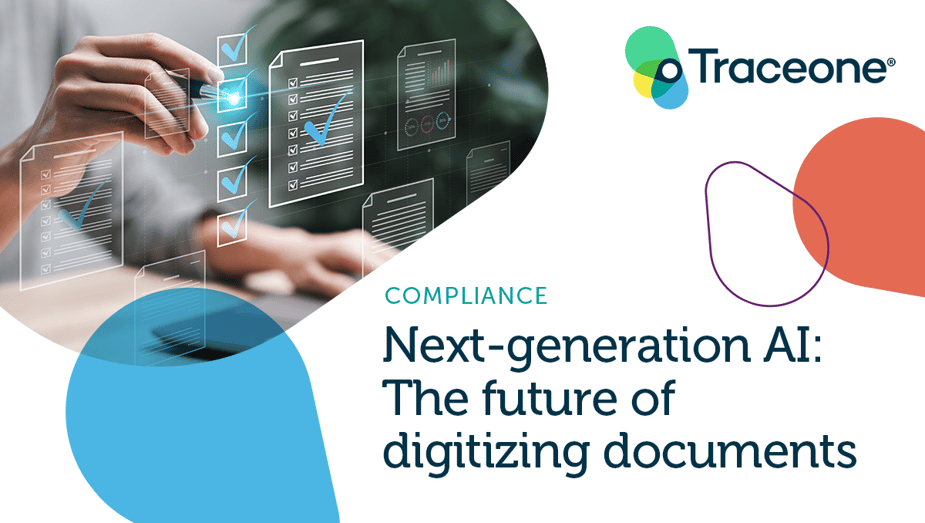
Next-generation AI: The Future of Digitizing Documents
|
Product Lifecycle Management
|
Regulatory
Posted By:
Trace One
If you’re in manufacturing, you know the sheer number of documents that come your way daily. There are safety data sheets (SDS), certificates of analysis (COA), technical data sheets (TDS), and more, all intended to handle the flow of information throughout your supply chain and manufacturing process.
The stakes of getting documentation right are enormous. Errors can result in slower time to market, sanctions from regulatory bodies, blockages at customs, costly recalls, and damage to all-important brand reputation.
At the same time, creating and interpreting documents and the data they contain is a daunting task for human operators. Searching through mountains of data can be challenging, and human beings are prone to error when they pull information together from different sources.
AI can pick up the slack
Where people struggle, AI excels. That’s especially true for documentation.
Generative AI has revolutionized how we manage the inflow and outflow of language and data. As a result of this new technology, access to information, documentation, and data sources is more rapid and intelligently contextual than ever before.
Whether users want to translate documentation into data within their enterprise manufacturing software or use existing data to create documents, generative AI’s natural language processing abilities and contextual understanding have the power to take on those tasks.
Digitizing documents with AI
Part of product lifecycle management (PLM) and ERP platforms’ power is storing vast quantities of documents related to products, substances, regulations, and suppliers. But that content can be difficult for users to find and access through conventional searches. As AI tools continue to evolve, they’ll be able to take on more and more of that search burden.
There are several concrete uses for AI in the manufacturing documentation space.
- AI tools can already capture documents and reformat their text to match formats like SDSs or COAs. As their algorithms get more sophisticated, they’ll improve that process by increasing speed and data quality.
- Conducting cross-search throughout documents in dispersed depositories and even different languages through natural language queries can save time for human operators.
- As a digital colleague and copilot, advanced AI can be useful for quality control, checking accuracy to catch any human errors and flag them to their users.
- AI is especially useful for tackling regionalized documentation demands. By sourcing data related to regional regulations, AI tools have the ability to both identify the relevant information for different regions and translate documents into local languages very rapidly.
By accelerating and streamlining the document digitization process, AI has the potential to speed up manufacturers’ work substantially. Synthesizing documents from extensive data repositories is just one part of the equation. Manufacturers will also benefit from more readily available data throughout their decision-making process.
How AI will revolutionize the manufacturing documentation process
Different documents present different opportunities for next-generation AI.
Safety data sheet (SDS)
SDSs can be particularly challenging for manufacturers because compliance, product, and substance data are constantly in flux from ever-evolving regulations and the natural course of the product lifecycle.

The most straightforward use for advanced AI in SDS creation is its powerful ability to comb through massive sources of information, pull out contextually appropriate elements, and compose an SDS in its proper format. On top of that, as regulations and relevant data change, AI will be able to automate document updates, eliminating the need for time-consuming reviews in rapidly changing environments.
Certificate of analysis (CoA)
CoAs present a particular challenge for manufacturers. Although they tend to include much of the same information, their format varies from supplier to supplier. Breaking that information into its most important content and manually inputting it into PLM or ERP systems can be difficult and time-consuming.
This is an area where advanced AI is particularly powerful. It has the power to understand and categorize different kinds of information—even across disparate formats and languages. By digitizing that information and recognizing its underlying values, these tools will be able to pull data into enterprise software quickly and accurately for conformity, supplier assessment, and other essential tasks.
Technical data sheet (TDS)
Not unlike an SDS, a TDS needs to present up-to-date product information drawn from a manufacturer’s overall data environment, even as that data evolves over time. And like COAs, TDSs come in highly variable formats.
Next-generation AI will be able to tackle these challenges through automation by managing the outflow and adaptation of continually updating enterprise data into TDSs. And all of that activity can easily translate across different formats and languages according to regulatory and regional demands.
Getting ready for AI document digitization with Trace One tools
With over 30 years of experience working closely with manufacturers, Trace One intimately understands the challenges of manufacturing. As a result, we have plenty of experience rolling out new technological advances in this space.
Most importantly, our enterprise PLM solutions reach across every part of the manufacturing process—from supplier relations through consumer-facing labeling. The richer and more connected your data ecosystem, the more effective next-generation AI will be at managing the inflow and outflow of manufacturing data. That lays the groundwork for greater speed and accuracy in document digitization—and ultimately, a smoother manufacturing process.
The first step is building that connected, data-rich ecosystem with Trace One solutions.
Explore Trace One solutions and get ready for the AI revolution in document digitization.
